Abstract
Ecological gradients in natural and sexual selection often result in evolutionary diversification of morphological, life history, and behavioral traits. In particular, elevational changes in habitat structure and climate not only covary with intensity of sexual selection in many taxa, but may also influence evolution of mating signals. Here we examined variation in courtship song in relation to elevation of breeding across cardueline finches—a subfamily of birds that occupies the widest elevational range of extant birds and shows extensive variation in life histories and sexual selection along this range. We predicted that decrease in sexual selection intensity with elevation of breeding documented in this clade would result in a corresponding evolutionary reduction in elaboration of courtship songs. We controlled for the effects of phylogeny, morphology, and habitat structure to uncover a predicted elevational decline in courtship song elaboration; species breeding at lower elevations sang more elaborated and louder songs compared to their sister species breeding at higher elevations. In addition, lower elevation species had longer songs with more notes, whereas frequency components of song did not vary with elevation. We suggest that changes in sexual selection account for the observed patterns of song variation and discuss how elevational gradient in sexual selection may facilitate divergence in mating signals potentially reinforcing or promoting speciation.


Similar content being viewed by others
References
Andersson M (1994) Sexual selection. Princeton University Press, Princeton
Andersson M, Simmons LW (2006) Sexual selection and mate choice. Trends Ecol Evol 21:296–302
Arnaiz-Villena A, Alvarez-Tejado M, Ruiz-del-Valle V, Garcia-de-la-Torre C, Varela P, Recio MJ, Ferre S, Martinez-Laso J (1998) Phylogeny and rapid northern and southern hemisphere speciation of goldfinches during the miocene and pliocene epochs. Cell Mol Life Sci 54:1031–1041
Arnaiz-Villena A, Alvarez-Tejado M, Ruiz-del-Valle V, Garcia-de-la-Torre C, Varela P, Recio MJ, Ferre S, Martinez-Laso J (1999) Rapid radiation of canaries (genus Serinus). Mol Biol Evol 16:2–11
Badyaev AV (1997a) Avian life history variation along altitudinal gradients: an example with cardueline finches. Oecologia 111:365–374
Badyaev AV (1997b) Covariation between life history and sexually selected traits: an example with cardueline finches. Oikos 80:128–138
Badyaev AV (1997c) Altitudinal variation in sexual dimorphism: a new pattern and alternative hypotheses. Behav Ecol 8:675–690
Badyaev AV, Leaf ES (1997) Habitat associations of song characteristics in Phylloscopus and Hippolais warblers. Auk 114:40–46
Badyaev AV, Ghalambor CK (2001) Evolution of life histories along elevational gradients: trade-off between parental care and fecundity in birds. Ecology 82:2948–2960
Badyaev AV, Hill GE (2003) Avian sexual dichromatism in relation to phylogeny and ecology. Annu Rev Ecol Syst 34:27–49
Badyaev AV, Qvarnström A (2002) Putting sexual traits into the context of an organism: a life-history perspective in studies of sexual selection. Auk 119:301–310
Badyaev AV, Snell-Rood EC (2006) Rapid evolutionary divergence of environment-dependent sexual traits in speciation: a paradox? Acta Zool Sin 52:315–319
Badyaev AV, Hill GE, Weckworth BV (2002) Species divergence in sexually selected traits: increase in song elaboration is related to decrease in plumage ornamentation in finches. Evolution 56:412–419
Ballentine B, Badyaev A, Hill GE (2003) Changes in song complexity correspond to periods of female fertility in blue grosbeaks (Guiraca caerulea). Ethology 109:55–66
Berven KA (1982) The genetic basis of altitudinal variation in the wood frog Rana syvatica. I. An experimental analysis of life history traits. Evolution 36:962–983
Boncoraglio G, Saino N (2007) Habitat structure and the evolution of bird song: a meta-analysis of the evidence for the acoustic adaptation hypothesis. Funct Ecol 21:134–142
Bowman RI (1979) Adaptive morphology of song dialects in Darwin’s finches. J Ornithol 120:353–359
Boyce MS (1979) Seasonality and patterns of natural selection for life histories. Am Nat 114:569–583
Chenoweth SF, Blows MW (2003) Signal trait sexual dimorphism and mutual sexual selection in Drosophila serrata. Evolution 57:2326–2334
Clement P, Harris A, Davis J (1993) Finches and sparrows: an identification guide. Princeton University Press, Princeton
Coyne JA, Orr HA (2004) Speciation. Sinauer, Sunderland
Darwin C (1859) On the origin of species. Murray, London
Draganoiu TI, Nagle L, Kreutzer M (2002) Directional female preference for an exaggerated male trait in canary (Serinus canaria) song. Proc R Soc Lond B Biol 269:2525–2531
Endler JA (1992) Signals, signal conditions, and the direction of evolution. Am Nat 139:S125–S153
Forstmeier W, Kempenaers B, Meyer A, Leisler B (2002) A novel song parameter correlates with extra-pair paternity and reflects male longevity. Proc R Soc Lond B Biol 269:1479–1485
Garamszegi LZ, Moreno J, Møller AP (2006) Avian song complexity is associated with high field metabolic rate. Evol Ecol Res 8:75–90
Grant BR, Grant PR (1996) Cultural inheritance of song and its role in the evolution of Darwin’s finches. Evolution 50:2471–2487
Grant PR, Grant BR (1997) Genetics and the origin of bird species. Proc Natl Acad Sci USA 94:7768–7775
Grant BW, Dunham AE (1990) Elevational covariation in environmental constraints and life histories of the desert lizard Sceloporus merriami. Ecology 71:1765–1776
Grether GF, Hudon J, Millie DF (1999) Carotenoid limitation of sexual coloration along an environmental gradient in guppies. Proc R Soc Lond B Biol 266:1317–1322
Haavie J, Borge T, Bures S, Garamszegi LZ, Lampe HM, Moreno J, Qvarnström A, Torok J, Saetre G-P (2004) Flycatcher song in allopatry and sympatry—convergence, divergence, and reinforcement. J Evol Biol 17:227–237
Howard JH, Wallace RL (1985) Life history characteristics of populations of the long-toed salamander (Ambystoma macrodactylum) from different altitudes. Am Midl Nat 113:361–373
Irwin DE (2000) Song variation in an avian ring species. Evolution 54:998–1010
Irwin DE, Price T (1999) Sexual imprinting, learning and speciation. Heredity 82:347–354
Lachlan RF, Feldman MW (2003) Evolution of cultural communication systems: the coevolution of cultural signals and genes encoding learning preferences. J Evol Biol 16:1084–1095
Lachlan RF, Servedio MR (2004) Song learning accelerates allopatric speciation. Evolution 58:2049–2063
Lohr B, Wright TF, Dooling RJ (2003) Detection and discrimination of natural calls in masking noise by birds: estimating the active space of a signal. Anim Behav 65:763–777
Magrath MJL, Komdeur J (2003) Is male care compromised by additional mating opportunity? Trends Ecol Evol 18:424–430
Marten JA, Johnson NK (1986) Genetic relationships of North American Cardueline finches. Condor 88:409–420
Martin TE, Badyaev AV (1996) Sexual dichromatism in birds: importance of nest predation and nest location for females versus males. Evolution 50:2454–2460
Mathies T, Andrews RM (1995) Thermal and reproductive biology of high and low elevation populations of the lizard Sceloporus scalaris: implications for the evolution of viviparity. Oecologia 104:101–111
Mayr E (1940) Speciation phenomena in birds. Am Nat 74:249–278
Møller AP, Chabi Y, Cuervo JJ, De Lope F, Kilpimaa J, Kose M, Matyjasiak P, Pap PL, Saino N, Sakraoui R, Schifferli L, von Hirschheydt J (2006) An analysis of continent-wide patterns of sexual selection in a passerine bird. Evolution 60:856–868
Morton ES (1975) Ecological sources of selection on avian sounds. Am Nat 109:17–34
Nolan PM, Hill GE (2004) Female choice for song characteristics in the house finch. Anim Behav 67:403–410
Nowicki S, Searcy WA (2005) Song and mate choice in birds: how the development of behavior helps us to understand function. Auk 122:1–14
Nowicki S, Peters S, Podos J (1998) Song learning, early nutrition and sexual selection in songbirds. Am Zool 38:179–190
Patricelli GL, Blickley JL (2006) Avian communication in urban noise: causes and consequences of vocal adjustment. Auk 123:639–649
Patten MA, Rotenberry JT, Zuk M (2004) Habitat selection, acoustic adaptation, and the evolution of reproductive isolation. Evolution 58:2144–2155
Podos J (2001) Correlated evolution of morphology and vocal signal structure in Darwin’s finches. Nature 409:185–188
Podos J, Huber SK, Taft B (2004) Bird song: the interface of evolution and mechanism. Annu Rev Ecol Evol Syst 35:55–87
Potapov RL (2004) Adaptations of birds to life in high mountains in Eurasia. Acta Zool Sin 50:970–977
Price T (1997) Correlated evolution and independent contrasts. Philos Trans R Soc B 352:519–529
Price T (1998) Sexual selection and natural selection in bird speciation. Philos Trans R Soc B 353:251–260
Qvarnström A, Haavie J, Sæther SA, Eriksson D, Pärt T (2006) Song similarity predicts hybridization in flycatchers. J Evol Biol 19:1202–1209
Read AF, Weary DM (1990) Sexual selection and the evolution of bird song: a test of the Hamilton–Zuk hypothesis. Behav Ecol Sociobiol 26:47–56
Reid JM, Arcese P, Cassidy ALEV, Hiebert SM, Smith JNM, Stoddard PK, Marr AB, Keller LF (2005) Fitness correlates of song repertoire in free-living song sparrows (Melospiza melodia). Am Nat 165:299–310
Richards DG, Wiley RH (1980) Reverberations and amplitude fluctuations in the propagation of sound in a forest: Implications for animal communication. Am Nat 115:381–399
Ruegg K, Slabbekoorn H, Clegg S, Smith TB (2006) Divergence in mating signals correlates with ecological variation in the migratory songbird, Swainson’s thrush (Catharus ustulatus). Mol Ecol 15:3147–3156
Ryan MJ, Brenowitz EA (1985) The role of body size, phylogeny, and ambient noise in the evolution of bird song. Am Nat 126:87–100
Schluter D (2000) Ecology of adaptive radiation. Oxford University Press, New York
Searcy WA, Andersson M (1986) Sexual selection and the evolution of song. Annu Rev Ecol Syst 17:507–533
Servedio MR (2004) The evolution of premating isolation: local adaptation and natural and sexual selection against hybrids. Evolution 58:913–924
Shuster SM, Wade MJ (2003) Mating systems and strategies. Princeton University Press, Princeton
Slabbekoorn H, den Boer-Visser A (2006) Cities change the songs of birds. Curr Biol 16:2326–2331
Slabbekoorn H, Smith TB (2002) Bird song, ecology and speciation. Philos Trans R Soc B 357:493–503
Snook RR, Robertson A, Crudgington HS, Ritchie MG (2005) Experimental manipulation of sexual selection and the evolution of courtship song in Drosophila pseudoobscura. Behav Genet 35:245–255
Svensson EI, Eroukhmanoff F, Friberg M (2006) Effects of natural and sexual selection on adaptive population divergence and premating isolation in a damselfly. Evolution 60:1242–1253
Traylor MA (1950) Altitudinal variation in Bolivian birds. Condor 52:123–126
Ward S, Speakman JR, Slater PJB (2003) The energy cost of song in the canary, Serinus canaria. Anim Behav 66:893–902
West-Eberhard MJ (1983) Sexual selection, social competition, and speciation. Q Rev Biol 58:155–183
Wiley RH, Richards DG (1978) Physical constraints on acoustic communication in the atmosphere: implications for the evolution of animal vocalizations. Behav Ecol Sociobiol 3:69–94
Wood WE, Yezerinac SM (2006) Song sparrow (Melospiza melodia) song varies with urban noise. Auk 123:650–659
Wynne-Edwards KE (1998) Evolution of parental care in Phodopus: conflict between adaptations for survival and adaptations for rapid reproduction. Am Zool 38:238–250
Zang H (1980) The altitudinal influence on the population density and on the breeding biology of Ficedula hypoleuca, Parus palustris, Parus major, and Parus ater in the Harz Mountains (Germany). J Ornithol 121:371–386
Acknowledgements
We thank R. L. Young, K. P. Oh, and two anonymous reviewers for comments on previous versions of this manuscript and discussion. This study was supported in part by National Science Foundation Pre-doctoral Fellowship to E. S. R. This research complies with the current laws of the United States.
Author information
Authors and Affiliations
Corresponding author
Additional information
Communicated by Scott Robinson.
Electronic supplementary material
Below is the link to the electronic supplementary material.
Rights and permissions
About this article
Cite this article
Snell-Rood, E.C., Badyaev, A.V. Ecological gradient of sexual selection: elevation and song elaboration in finches. Oecologia 157, 545–551 (2008). https://doi.org/10.1007/s00442-008-1092-0
Received:
Accepted:
Published:
Issue Date:
DOI: https://doi.org/10.1007/s00442-008-1092-0




